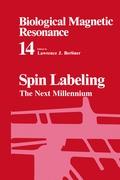Spin Labeling
BücherAngebote / Angebote:
We present here the second issue devoted entirely to the spin-labeling technique as part of Biological Magnetic Resonance. Volume 14 commemorates a modifi- tion in our editorial policy with the retirement of my esteemed coeditor, Jacques Reuben. From thisjuncture into the future, each issue will focus on some special topic in magnetic resonance. Each volume will be organized in most cases by guest editors, for example forthcoming issues will address the following topics: in vivo magnetic resonance (P. Robitaille and L. J. Berliner, eds. ) Modern techniques in proton NMR ofproteins (R. Krishna and L. J. Berliner, eds. ) Instrumental techniques of EPR (C. Bender and L. J. Berliner, eds. ) Thecurrent volume, Spin Labeling: The NextMillennium, presents an excellent collection of techniques and applications that evolved during the past decade since the last volume, volume 8 (1989). Someobvious omissions, such as multiquantum EPR and very high-frequency FT-ESR were unfortunately not possible for this volume. Perhaps they will appear in Spin Labeling: 2001. Lastly it is a pleasure to honor two scientists whose contributions were both pioneering and pivotal to the spin label technique: Professor Eduard G. Rozantsev (Moscow), whose synthetic feats in nitroxyl chemistry set the broad stage for a versatile catalog of labels, and Professor Harden M. McConnell, last year's Int- national ESR (EPR) Society Gold Medalist, who conceived and developed the spin label technique to address many biological problems (proteins, enzymes, m- branes, cells, immune response, etc. ). Lawrence J.
Folgt in ca. 15 Arbeitstagen




